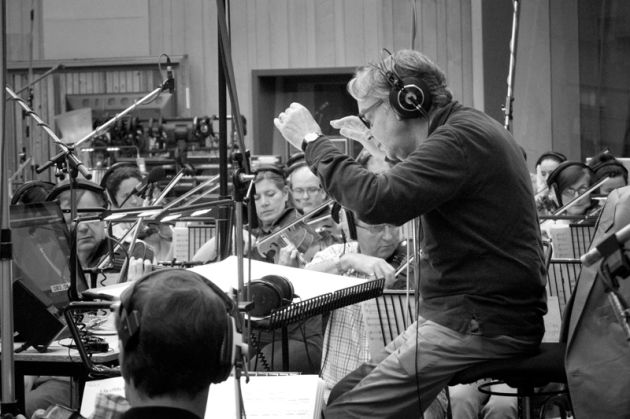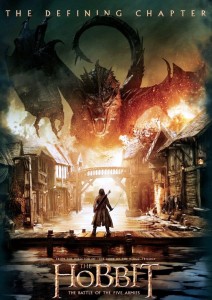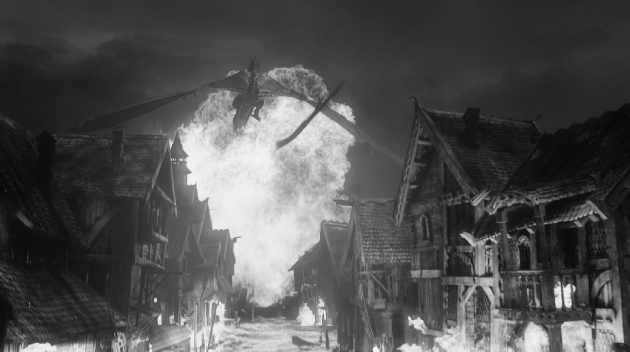
When An Unexpected Journey arrived in theaters back in 2012, we finally journeyed back into Peter Jackson’s cinematic take on Middle-earth. Featuring many familiar faces and places, this was a second chance to visit this strange world yet again. Clearly the filmmakers wanted to go to great effort to tie these prequels into the same tone as The Lord of the Rings.
No where was this felt more than in the many musical callbacks, ranging from the rustic fiddles of the Shire to the rising crescendoes of Rivendell. Back in the first trilogy, composer Howard Shore rigorously applied the concept of Wagnerian leitmotifs across the three films, developing expansive and evolving musical themes each tied to important themes, characters, relationships, and locations. Like the production of an entire trilogy all at once, this had never really been done. And now it looked like Shore might do it again for The Hobbit.
However at An Unexpected Journey‘s release many critics expressed disappointment that both the film and its accompanying score fell far short of the magisterial heights of the first three Middle-earth films. Blaming a lack of source material, slow pacing, overt use of CGI, and comical tone, concerned reviewers felt that the new film was not up to par. Concerning Howard Shore’s efforts in particular they leveled several accusations.
First, many felt that Shore’s music relied far too much on the pre-established themes of The Lord of the Rings rather than standing on its own. Critics questioned the score’s dependency on the familiar leitmotifs for the Shire, the One Ring, Rivendell, Gollum, A Hobbit’s Understanding, and the Eagles.
In addition,the score featured a liberal dose of the Misty Mountains song first sung by Thorin and Company. Not written by Shore himself, the melody was composed by the New Zealand group Plan 9. Feeling that this non-Shore theme was both the best new melody of the film and yet at the same time largely overused, critics seemed to agree that the 66-year old Shore had lost some of his mojo.
Conspicuously, there were also some major last minute changes made to the score. Many segments in the released soundtrack were completely absent from theatrical release. In addition, new themes in the movie were nowhere to be found on the original soundtrack.
Changes in the film include a much pared down Radagast theme, various repetitions of the Misty Mountains theme, a new sweeping choral piece for the Eagles, and the controversial repurposing of several key leitmotifs from The Lord the Rings, specifically the themes of the Ringwraiths, Lothlorien, Nature’s Reclamation, and Gondor Reborn.
These missing themes from the soundtrack and late additions to the theatrical cut caused some consternation. Diehard fans familiar with these theme’s associations in The Lord of the Rings were perplexed at their reuse in An Unexpected Journey. Why were the originally intended themes from the soundtrack replaced with the repurposed ones from the original trilogy?
At the end of the day, the exact reasons are unknown. But we can be fairly confident that these late decisions were made directly by Peter Jackson and Howard Shore upon viewing a close-to-final cut of the film. The recorded music they had wasn’t working well as it should have. And Shore, known for his consistent detail to the meaning of leitmotifs in The Lord of the Rings, now incorporated these preestablished leitmotifs into An Unexpected Journey. While we can’t know why, we can reflect upon what old themes were used and what Wagnerian connections Shore might be making.
Let’s look individually at four most controversial leitmotifs and examine just why they may have been employed.
LOTHLORIEN
Listen the theme here.
This theme is used when the Company slides down to the hidden path to Rivendell and a hunting party of elves take out Azog’s warg-riders. This theme is first heard in The Fellowship of a Ring as a mystical choral piece when the Fellowship enters Lothlorien. This beg the question, what do Elrond and the warriors of Rivendell have to do with Lothlorien?
Rivendell elves have their own music completely separate from Lothlorien elves (as do the Wood-elves.) It could be easily argued that swapping themes between elves cheapens their use.
But as it turns out, Howard Shore has only used this particular battle version of the theme once before. It occurs in The Two Towers when elves from Lothlorien arrive at Helm’s Deep. However there is a Rivendell connection after all. Here’s the context. Previously Galadriel asks Elrond in Rivendell telepathically if the elves should leave Middle-earth to its fate or if they should in fact step in and aid men. Fast-forward to Helm’s Deep, the Lothlorien battle music plays as Haldir leads 200 Galadhrim archers inside the gates.
When he arrives, Haldir’s exact words are as follows:
I bring word from Elrond of Rivendell. An alliance once existed between Elves and Men. Long ago we fought and died together. We come to honor that allegiance. We are proud to fight alongside men once more.
Even though these elves are from Lothlorien, for whatever reason the impetus for their arrival seems to rest on the decision of Elrond. It is by the authority of Rivendell that these elves have come. And as we know, Elrond fought alongside men in the War of the Last Alliance and was gravely disappointed when Isildur refused to destroy the One Ring. Although technically the Lothlorien theme belongs to Lothlorien, as it is established in The Two Towers this leitmotif also has connections to Elrond and the former alliance that once existed between elves and men.
And when this theme resurfaces in An Unexpected Journey, who of course is leading elven archers to the last minute rescue of non-elves? It is Elrond again. Could Shore have created or extrapolated a brand new theme for this brief appearance? He could have, but instead he picked a theme that already had close ties to battling elves, an alliance between elves and non-elves, Rivendell, and Elrond himself.
As we will see in the next few leitmotifs, Shore’s reuse and repurposing of familiar themes never arrive completely out of the blue. They always build some kind of thematic connection between something we have seen before and what is now happening in an unfamiliar but similar variation.
Where the problem arises is when we take a theme like “Lothorien,” give it a static name as such, and then refuse to see any other circumstance which is not as literally similar. Even though some of these definitive leitmotif names do come from official sources, just because they have been given a name shouldn’t negate the fact that Shore’s music is always evolving and growing. Why should Shore be limited by a name picked out 10 years ago when there were only three Middle-earth films? Given Shore and Jackson’s history of meticulous attention to detail and unprecedented level of leitmotif development across multiple films, I believe that the use of these themes, though at times difficult to fully understand, are always intentional.
RINGWRAITHS
Watch an example here
In An Unexpected Journey a pounding version of this chanting chorus plays when Thorin sees Azog for the first time and runs through the burning branches to challenge him. For many diehard fans of the LOTR soundtrack, this music actually took them completely out of the moment. Why was the theme for the Ringwraiths playing when there were no Ringwraiths in sight?
As perhaps my favorite moment in The Hobbit films so far, it took me a while to understand why this was so disconcerting. Listening to the released soundtrack, Shore originally had a completely different idea in mind for this moment. Late in post-production Shore re-recorded a version of this old theme and inserted it into this sequence.
As jarring as it is for some, especially those who own the Doug Adam’s book, it’s very possible that Shore simply decided to expand the use of this particular theme beyond the narrow confines of the Ringwraiths. There is already one instance where this has precedent: the first introduction of this theme in the prologue of The Fellowship of the Ring. It is here at the Battle of Dagorlad during the War of the Last Alliance that we see this theme’s primary association is with Sauron and his army. Although perhaps we forget it later on in the trilogy, the Ringwraiths’ use of this theme is as primarily and thematically as an extension of Sauron himself. As direct agents of Sauron’s will, the Nine only do what their master commands them bound eternally by their rings of power. Fittingly their music belongs to Sauron as well.
So by claiming this leitmotif as the Ringwraith theme all along we have been forgetting that this is really the theme of Sauron, first used for his charging orc battalions at Dagorlad and then next used for his embodied armored form as he wields the ring. It is only afterward that this leitmotif is used for his nine servants of evil. By playing this theme over Azog (who clearly has his own distinct theme of dissonant notes in the lower register) Shore is making a strong association between the Defiler and the will of Sauron. You might not like the overt way this thematic connection is made, but it is there.
In The Desolation of Smaug, we see this relationship confirmed. Azog is no ordinary orc. We discover he is actually the commander of Sauron’s armies and that the elimination of Thorin’s claim to Erebor is indeed the Dark Lord’s number one military priority. He is building an army to claim the mountain for himself. Sauron would like nothing more than for Azog to cripple the Free People of the North for good, recruit a dragon to unleash upon his enemies as he has in the past, and use the gold of Erebor to buy the allegiance of easily corruptible men. At the moment Azog the Defiler is Sauron’s chief servant, very much like the Witch-king will be later on. By employing this obvious theme, a theme that establishes Sauron in the prologue and later defines his chief servants, Shore is making a statement. It may not be a subtle or veiled statement, but the meaning is pretty clear. If you want to know what Sauron is up to in The Hobbit, you need only look at Azog.
To speculate further, it’s possible there are more connections that we just haven’t unearthed yet. We don’t know exactly what will happen in The Battle of the Five Armies, especially concerning Azog, the Ringwraiths, and Sauron since none of them feature in the actual book of The Hobbit. However Jackson and crew have clearly decided to take Sauron’s Necromancer role literally, having him resurrect the Nazgul. As we know, Sauron is very good at overcoming things like death and disembodiment.
According to Tolkien, Azog was definitely killed at the battle of Azubiliazar outside the gates of Moria. Interestingly, Thorin offers the same explanation to Bilbo, claiming he died of his wounds long ago.
Is it possible that Sauron, a powerful necromancer, raised Azog from the dead just as he brought back the Nazgul?
That would explain the Pale Orc’s allegiance to Sauron which overrides his burning motivation to eliminate Thorin himself. If Azog has indeed been resurrected just like the Nine to be a servant of evil, this would make his relationship to the Ringwraiths and their musical cues even more appropriate. We will just have to wait for the next film and perhaps the extended editions to find out.
NATURE’S RECLAMATION
Listen to examples here.
There are several versions of this leitmotif used throughout the three LOTR films. It is used to signify the natural world or sometimes men taking back something that evil has stolen. Its first instance occurs as a soft boy solo used when the Lord of the Eagles reclaims Gandalf from the top of Orthanc. The most exemplary use of the Nature’s Reclamation theme occurs in The Two Towers when the Ents go to war and the Rohirrim ride down the hill to Helm’s Deep.
A few other uses are notable. In The Return of the King when Rohan arrives at the Battle of Pellenor Fields, a brass version of the theme plays over the men and horses as opposed to the usual chorus of boys used for the moths, eagles, and Ents. The theme last occurrence is when the eagles arrive outside the Black Gate.
In An Unexpected Journey, this theme is played when Gandalf sends the moth for help and the eagles snatch up the Company from the trees. This is pretty straightforward. It connects the two eagle appearances from LOTR to the eagle rescue in The Hobbit and makes thematic sense. The only issue I can see is that we have heard this theme quite a lot before, used in the climaxes of both The Two Towers and The Return of the King.
However if the theme is familiar, Howard Shore extrapolates further and leads into a stirring choral piece as the eagles carry the Company through the skies and a beautiful sunrise. Not found on the soundtrack, this is Shore at his best. Here he takes a relatively bare moment in the story and turns it into a beautiful meditation on the harrowing danger that Bilbo and his friends have just barely escaped from. The fact that this is also a late addition to the score should alert us to the fact that these last minute changes were not laziness. Shore is both willing to recycle and devise something utterly new as needed.
GONDOR REBORN
Watch an example here.
In the closing sequence of An Unexpected Journey, a wounded Thorin confronts Bilbo and warmly embraces him as the other dwarves cheer them on. It’s a moment that signals Bilbo’s acceptance into the Company and a turning point for Thorin and Bilbo’s relationship. However the music was changed at the last minute, reusing a theme known as Gondor Reborn. This perplexed many fans since this moment in The Hobbit has nothing to do with Gondor and comes off as thematically incongruent.
This Gondor Reborn cue comes from The Return of the King originally intended to mark the crowning of Aragorn and the dawn of the Fourth Age of Middle-earth. There are two especially notable uses of this leitmotif in the third film and both occur toward the end. The first takes place at the defeat of Sauron right as Barad-dur comes crashing down. A second use occurs at the crowning of King Elessar, signaling the titular return of Gondor’s royal lineage. What’s interesting is that only one of these uses has direct ties to Gondor. While I suppose the destruction of Barad-dur does very much affect Gondor’s survival, it’s not the same thing as Gondor being physically reborn through its reinstated monarch.
In fact, I believe in retrospect this theme is now misnamed. As presented in The Return of the King, it is not narrowly limited to Gondor’s revival. The theme signals the climactic defeat of evil and it’s also about celebrating the unexpected victory of hobbits over the larger forces of evil in the world. When Sauron’s lidless eye explodes and his tower crumbles, it is because of two brave hobbits. When Aragon receives his crown, it is in large part because of the four hobbits standing before him who outran Nazgul, convinced Ents to overthrow Saruman, deceived Sauron, and delivered the One Ring to Mount Doom. This theme is about the strength of ordinary everyday folk over the looming shadow of darkness. Though intended for Gondor and Elessar, late changes to The Return of the King seem to have expanded this leitmotif to encompass a much broader meaning.
Bilbo singlehandedly saved Thorin from Sauron’s agent, Azog the Defiler, and preserved the Quest for Erebor from certain doom. The dwarves cannot reclaim the mountain without a king and clearly his nephews are not ready to carry that mantle. They need a capable leader and a rightful heir of Durin to defeat Smaug and restore the throne of the Lonely Mountain.
One might argue that the embrace of a hobbit and a dwarf pales in comparison to the climactic defeat of Sauron and the crowning of the long-awaited king of Gondor, but one might also argue precisely the opposite. Bilbo prevents the quest from failure inspiring a chain of events that will lead to the destruction of Smaug and the restoration of Erebor and Dale. His actions directly lead to the reestablishment of a prosperous and strong civilization of dwarves and men in the North. If Thorin dies by Azog’s hand, Sauron’s armies will explode unchecked beginning in the North and spreading down through the rest of Middle-earth. It is Erebor and Dale who will fend off Sauron’s advances in the coming War of the Ring and keep his attention divided between themselves and Minas Tirith.
Shore uses this small moment to illustrate the greater meaning of the actions of a single hobbit. Though he cannot know it, Bilbo’s courage affects the fortunes of many across the whole of Middle-earth. And as Gandalf reminds us, only deeds of ordinary folk like this can stop Sauron. This emotional orchestral theme is all at once victorious, celebratory, and illuminating. Just as it will happen gloriously in The Return of the King, in this short moment a hobbit quietly thwarts a great evil.
 I’ve written tens of thousands of words on the Hobbit trilogy. It truly appears that there is nothing left for me to say about it. But it’s not over. Not yet.
I’ve written tens of thousands of words on the Hobbit trilogy. It truly appears that there is nothing left for me to say about it. But it’s not over. Not yet.

